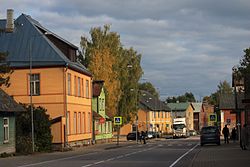Abja-Paluoja
Town in Estonia From Wikipedia, the free encyclopedia
Abja-Paluoja is a town in Mulgi Parish, Viljandi County, in southern Estonia. Abja-Paluoja got the town status and became a separate urban municipality in 1993.
Abja-Paluoja | |
|---|---|
 Main street in Abja-Paluoja | |
| Coordinates: 58°07′33″N 25°21′31″E | |
| Country | Estonia |
| County | Viljandi County |
| Municipality | Mulgi Parish |
| Town status | 1993 |
| Population (2018)[1] | |
• Total | 1,057 |
| • Rank | 44th |
| Time zone | UTC+2 (EET) |
History
First documented records of the Abja manor and village date from 1457 (Abbalis et Meitzekull).
From 1897 to 1973, the railway line passed through Abja-Paluoja, and there was a railway station in the town.
In 1913, a flax factory was established near Abja-Paluoja because flax cultivation had developed in the area.
The Abja Gymnasium (secondary school) was opened in 1940.
Abja-Paluoja was the centre of Abja raion from 1950 to 1962. Abja-Paluoja gained town rights and became a separate urban municipality in 1993. In 1998, it was merged into surrounding rural municipality (Abja Parish) and was its administrative centre until 2017.
Notable people
- Karl August Hindrey (1875–1947), writer, journalist, and cartoonist
- Aino Jõgi (1922–2013), linguist and translator
- Kaimo Kuusk (born 1975), diplomat and foreign intelligence officer[2]
- Mati Laur (born 1955), historian
- Tarmo Pihlap (1952–1999), singer and guitarist
- Riho Västrik (born 1965), filmmaker, producer, screenwriter, journalist, and historian[3]
Gallery
- Park in central Abja-Paluoja
- Abja Museum in the historic bank and post office building
- Former railway station (now the building is used by a Pentecostal congregation)
- Fire depot
- Bus station
- Sports and Health Centre
References
External links
Wikiwand - on
Seamless Wikipedia browsing. On steroids.








